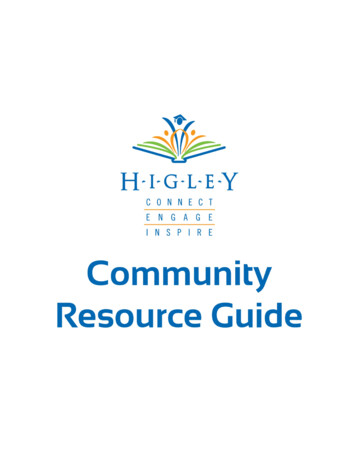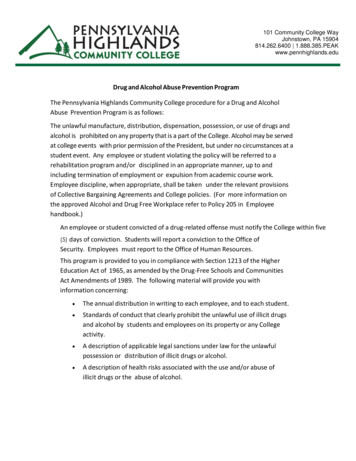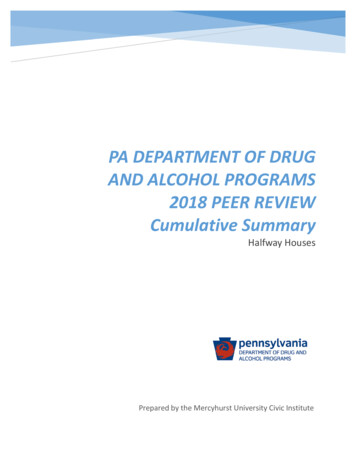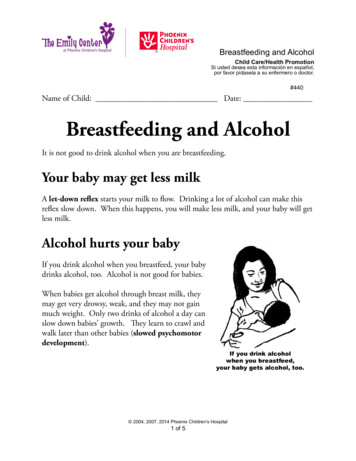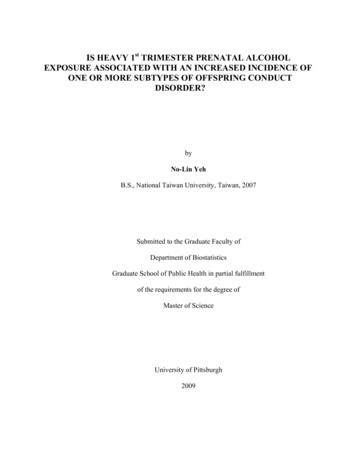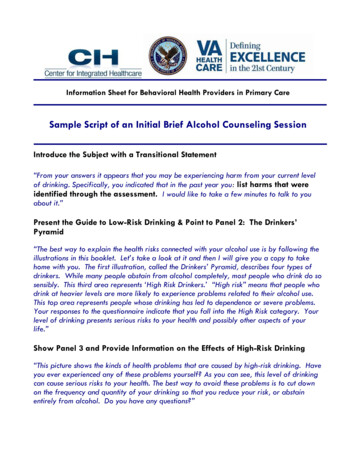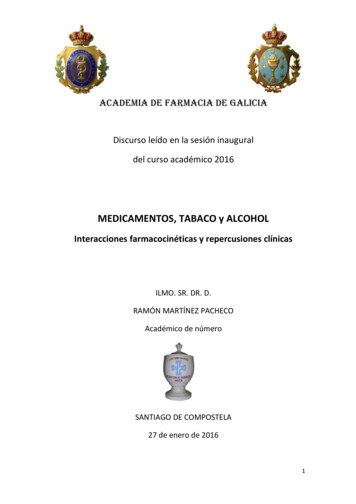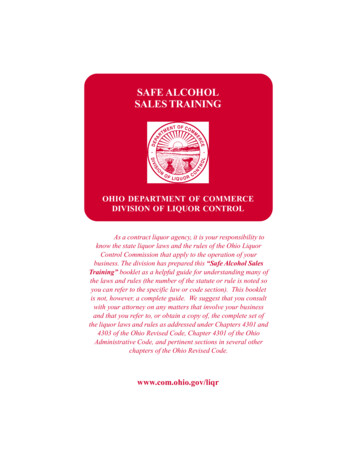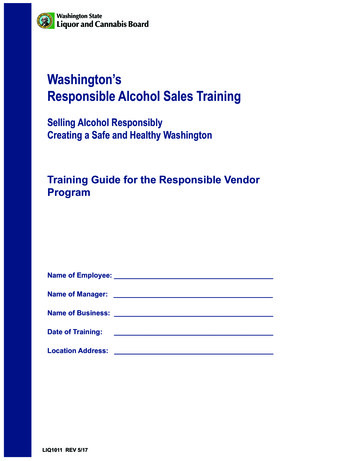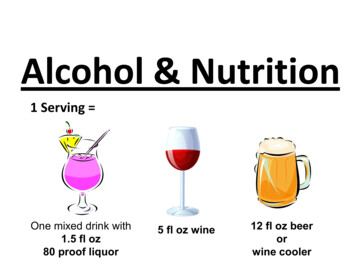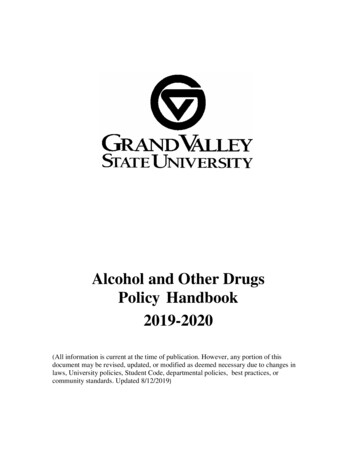
Transcription
Alcohol and Other DrugsPolicy Handbook2019-2020(All information is current at the time of publication. However, any portion of thisdocument may be revised, updated, or modified as deemed necessary due to changes inlaws, University policies, Student Code, departmental policies, best practices, orcommunity standards. Updated 8/12/2019)
TABLE OF CONTENTSIntroduction3Standards of Conduct4Drug-Free Workplace Act of 1988Compliance as a Condition of EmploymentMaintenance of a Drug-Free WorkplaceEmployee Obligation for Notification of ConvictionSanctions for Violation or Non-Compliance (Faculty, Staff, Students)4Drug-Free Schools and Communities Act of 19895Health Risks Related to Alcohol and Other Drugs6Legal Sanctions and Summary of Laws10University Sanctions for Students – Additional Information15Drug and Alcohol Prevention, Counseling, Rehabilitation, andRe-Entry Programs (Faculty, Staff, Students)17Treatment of Student Records182
INTRODUCTIONGrand Valley State University (GVSU) strives to offer members of the Universitycommunity the same rights as those afforded to members of the larger community. Allmembers of the University community are responsible for making decisions about theirbehavior within the context of state and federal law and University policies.These policy statements are written as evidence of GVSU’s commitment to its studentsby: Encouraging a campus environment where healthful choices are made; Working to prevent alcohol and other drug misuse and abuse; Accepting responsibility for one’s own choices, behavior and harm caused; Encouraging alcohol-free programs; Supporting and empowering those who responsibly choose not to use alcohol; Enforcing University, federal, state, and local codes, ordinances and statuteswhich govern alcohol and other drug useGVSU considers all issues of alcohol and other drugs (AOD) to be of concern to theUniversity community. However, alcohol is by far the number one drug of choice on thecampus and causes the most frequent negative impact. Thus, alcohol warrants a specialemphasis as demonstrated throughout this document.This Handbook contains information about University alcohol and drug abuse preventionprograms and policies, in accordance with requirements of the Drug-Free Schools andCommunities Act Amendments of 1989 and the Drug-Free Workplace Act of 1988. Anannual notice about the Handbook will be sent via email to faculty, staff and students, andprovision made for providing employees and students who were hired or who enrolledafter the annual distribution. A biennial review of the University alcohol and drug abuseprogram will be completed as required by law.Additional University policy documents related to alcohol and other drugs are availableonline and should be reviewed by all students, faculty and staff: Alcohol and Other Drugs Policy (www.gvsu.edu/policies)(This Handbook is a supplement to the Alcohol and Other Drugs Policy.)Smoking Policy – All GVSU Sites (www.gvsu.edu/policies)Student Code (www.gvsu.edu/studentcode)Annual Security and Fire Safety Report (www.gvsu.edu/gvpd)University policies related to alcohol and drug abuse prevention programs apply to allemployees working on federally sponsored agreements (grants and contracts).Individuals should contact the University Office of Sponsored Programs(http://www.gvsu.edu/grants/) for requirements specific to these agreements.3
Faculty, staff and students may consult appropriate departmental websites for proceduresrelated to the use of alcohol during special events, and/or in University facilities. Sites thatmay be of interest include: Housing Residential Support and Serviceshttp://www.gvsu.edu/housing/See "Policies and Amenities" under "Students" section of the website.Intercollegiate Athletics Fan Guideshttp://www.gvsulakers.com"Fan Guides" are available in the "Fan Info" section of the website.Conference and Event Planninghttp://www.gvsu.edu/meetatgvsu/ Event Serviceshttp://www.gvsu.edu/eventservices/ Student RDS OF CONDUCTThe unlawful manufacture, possession, use, sale, distribution or dispensation of illicit orprescription drugs and the unlawful possession, use, sale or distribution of alcohol byfaculty, staff, and students on GVSU property or as part of a University activity isspecifically prohibited by University policy, federal and state law (including underagedrinking laws). Reports of any such violations will be investigated by the GVSU PoliceDepartment and, if appropriate, charges will be filed.DRUG-FREE WORKPLACE ACT OF 1988Consistent with the Drug-Free Workplace Act of 1988, GVSU is committed to providing aworkplace which is free from the unlawful manufacture, distribution, dispensation,possession, sales, or use of a controlled substance. The illegal manufacture, distribution,dispensation, possession, or use of a controlled substance is prohibited on any GVSUowned or controlled property.It is the intent of GVSU to provide a drug-free, healthful, safe, and secure workenvironment. No employee will report to work evidencing any effects of illegal drug use.Compliance as a Condition of EmploymentAll university employees will, as a condition of employment, abide by the terms of thestandard practice guide.4
Maintenance of a Drug-Free WorkplaceGVSU must provide an annual drug-free workplace certification to appropriate federalfunding agencies, and make a good faith effort to comply with its certification to provide adrug-free workplace, and otherwise meet the requirements of the Drug-Free WorkplaceAct, including having a policy statement and a drug-awareness education program.The Human Resources Office ensures awareness of the policies through onboarding forfaculty and staff. The Employee Assistance Program provides drug education andresources for faculty and staff 24 hours a day seven days a week by calling 1-800-7888630.Employee Obligation for Notification of ConvictionThe Drug-Free Workplace Act of 1988 requires all faculty and staff to notify the Universityin writing of their conviction for a violation of a criminal drug statute occurring in theworkplace. Notification must be sent no later than five days after the conviction to theHuman Resources Office (1090 Zumberge Hall, Allendale, MI 49401, (616) 331-2215).Employees engaged in the performance of a federal grant must also notify the Director of theOffice of Sponsored Programs in writing, no later than five calendar days after such aconviction (Office of Sponsored Programs, 049 James H. Zumberge Hall, 616-331-6826). TheDirector will notify the appropriate granting agency within (10) ten days of receiving the noticeof conviction, in accordance with applicable requirements.Sanctions for Violation or Non-ComplianceViolations of this standard practice guide will result in personnel action against theemployee, up to and including dismissal, pursuant to university procedures relating toemployee or student discipline.Within thirty calendar days of receiving notice of a criminal drug statute conviction, theAssociate Vice President of Human Resources, or the Dean of Students must take steps torequire: 1) That the faculty, staff, or student employee satisfactorily participates in a drugrehabilitation program, or 2) That personnel action consistent with the Rehabilitation Actof 1973, as amended, is imposed in accordance with appropriate collective bargainingagreements, employee handbooks, the Student Code of Conduct(www.gvsu.edu/studentcode/), or other university procedures.Additional sanctions may apply to those employees working on a federally sponsoredgrant or contract and convicted of a criminal drug statute violation. In these cases, theDirector of the Office of Sponsored Programs will consult with the Associate VicePresident of Human Resources regarding the application of required sanctions.DRUG-FREE SCHOOLS AND COMMUNITIES ACT OF 1989University standards of conduct clearly prohibit, at a minimum, the unlawful possession,use, sale, or distribution of illegal drugs and alcoholic beverages by students andemployees on University property or as part of any of its activities. Supplementalinformation presented below includes: health risks associated with the use of alcohol and5
other drugs; a representative summary of laws (including Michigan underage drinkinglaws); applicable legal sanctions under local, State and Federal laws; disciplinarysanctions for student violations; and treatment and rehabilitation resources available forstudents, faculty and staff.HEALTH RISKS RELATED TO ALCOHOLAND OTHER DRUGSAlcohol and/or drug use can start out as experimentation or casual use but progress intoproblem use and dependence. The abuse of alcohol and other drugs can erode thefoundation of the University’s goals and objectives and diminishes the personal attainmentof intellectual, social, physical, and emotional growth and development. This includes: Psychological and/or physical dependence Impaired learning ability, memory loss, and inability to solve complex problems Inability to perform sexually, infertility problems Increased risk of sexually transmitted diseases (including HIV/AIDS) Complications due to the combination of prescription medication and other drugs oralcohol Death, coma or toxic reactions especially when combining alcohol with any other drug,including over-the-counter medicine or prescriptions Guilt/regret over activities performed while under the influence of alcohol/drugs, i.e.,regretting sexual encounters, fighting, risk-taking, legal difficulties, etc Organic damage to brain, cardiovascular system, liver, etc Increased risk of cancer Fetal Alcohol Syndrome, birth or genetic defects Psychosis (hallucinations, loss of contact with reality, extreme changes in personality). Diet deficiencies Inhibits absorption of vital nutrients May constrict metabolism and endorphins Impact on sleep Other physiological, psychological or interpersonal problemsAlcohol consumption causes a number of marked changes in behavior. Even low dosessignificantly impair the judgment and coordination required to drive a car safely,increasing the likelihood that the driver will be involved in an accident or make carelessmistakes when performing tasks. Low to moderate doses of alcohol increase the incidenceof a variety of aggressive acts and impact other functions such as perception, vision,thinking, tracking, concentration and attention. Moderate to high doses of alcohol causemarked impairments in higher mental functions, severely altering a person’s ability to learnand remember information. Very high doses cause respiratory depression and death. If6
combined with other depressants of the central nervous system, much lower doses ofalcohol will produce the effects of higher doses just described.Repeated use of alcohol can lead to dependence. If physically dependent, suddencessation of alcohol intake is likely to produce withdrawal symptoms, including severeanxiety, tremors, hallucinations and convulsions. Alcohol withdrawal can be lifethreatening. Long-term consumption of large quantities of alcohol, particularly whencombined with poor nutrition, also can lead to permanent damage to vital organs such asthe brain and the liver.Dangerous Drinking:Drinking on an empty stomach – Drinking on an empty stomach can cause alcohol to beabsorbed more quickly into the bloodstream and may lead to more sudden impairment andintoxication than expected.Alcohol and Cancer – A meta-analysis study confirms that alcohol increases the risk formany cancers (i.e. oral cavity, pharynx, esophagus, and larynx). There is also an increasedrisk for cancers of the stomach, colon, rectum, liver, female breasts, and ovaries.Drinking when pregnant - Alcohol can damage a fetus resulting in a birth defect known asFetal Alcohol Syndrome, which causes a distinct facial configuration and brain damage.Mothers who drink alcohol during pregnancy may give birth to infants with fetal alcoholsyndrome. These infants have irreversible physical abnormalities and cognitive deficits.Drinking while underage - Alcohol has twice the effect on teenage brains as it does onadults, resulting in permanent damage to memory and to the individual's abilities to learnnew information and to think critically. This can also lead to delays in personal andemotional developmental. Being ticketed for underage drinking or a Minor in Possession(MIP) also carries financial penalties. A second or third MIP may include loss of driver'slicense, jail time, probation, higher fines, and costs for lawyers and court fees.Drinking when taking medication - Many medications can interact with alcohol, leadingto increased risk of illness, injury, or death. It is estimated that alcohol-medicationinteractions may be a factor in at least 25% of all emergency room admissions.Drinking if you have alcoholism in the family - If you have inherited the genetics foralcoholism from parents or grandparents, drinking alcohol may trigger the disease,leading to the progression of the disease at an earlier age. Most recovered alcoholics saythat they essentially "fell in love" with alcohol when they first used it, usually at the ageof 10 - 15. See the definitions for Misuse, Abuse and Dependence to determine whetheror not you are in danger of addiction to alcohol.Drinking and ADHD - Research indicates that children of alcoholic parents may be atgreater risk than other children of becoming alcoholics. Also, children who have severeAttention-Deficit/Hyperactivity Disorder (ADHD) are at greater risk of developing alcoholor other drug problems later in life.7
Drinking too much, too fast / Drinking competitively – e.g., drinking games.Drinking more than one standard drink per hour does not allow the body enough time todigest alcohol. This leads to a rapidly increasing blood alcohol concentration.Drinking one within an hour of driving - After one drink, a driver begins to lose theability to perform the tasks necessary to drive a car: braking, steering, changing lanes,and using judgment to adjust to changing road conditions.Drinking and sexual assault – While using substances does not cause someone toperpetrate or experience sexual assault, substance use can be a heightened risk factor and ispresent in 50% of all violent crimes (Collins and Messerschmidt, 1993). Alcohol is thenumber one drug used to facilitate a sexual assault; 70% of college women who aresexually assaulted report drinking alcohol at the time of the assault (Orchowski & Gidycz,2012). Studies show perpetrators consuming alcohol 34-74% of the time (Abbey, Ross, &McDuffie, 1994; Abbey, 2002). Less common, yet still important to note, substances suchas Rohypnol, GHB, and Ketamine can be slipped into one’s drink to be used to facilitate asexual assault. A member of the GVSU community who has experienced a sexual assaulthas the right to file a complaint with the GVSU Title IX Coordinator. Additionally, theymay seek support from GVSU resources such as Victim Advocacy services located in theGayle R. Davis Center for Women and Gender Equity. Counseling services are alsoavailable through the University Counseling Center for students or Encompass for facultyand staff.“Safe” Use Is:"Safe" (or appropriate or responsible) use of drugs, including alcohol, is generallydefined as either "moderate" use or use which follows a prescription for a particularcondition as diagnosed by a medical doctor.There is no "safe" use of illegal drugs, nor is there a guaranteed safe use of alcohol,caffeine, aspirin or other legal drugs available without a prescription. However, it isgenerally believed that occasional and moderate use of legal drugs is safe for mosthealthy adults over the age of 21.The U.S. Department of Health and Human Services and the Department of Agriculture(re. nutrition), tell us that most healthy adults will have few, if any, negative effects fromhaving one serving of alcohol per day, the maximum limit for women or, for men, twoservings per day. (One serving 12 oz. of beer (5% alcohol), 6 oz. of wine, 1.5 oz. of 80proof liquor). Note: Keep in mind that many craft beers have a higher alcohol content.However, even one drink per day slightly increases the chances of breast cancer and canbe dangerous to certain individuals depending upon their age and medical condition.Also, keep in mind that “safe use” is questionable if a person has agenetic predisposition for addiction.8
Definitions: Misuse, Abuse, and DependenceMisuse of Alcohol - drinking too much or drinking for the wrong reasons, e.g., havingmore than one drink per day for women or more than two drinks per day for men, orusing alcohol to "self-medicate" oneself for struggles with depression or anxiety. Forinstance, drinking enough to "forget" an emotionally upsetting event. Or, drinking inorder to overcome "shyness" at a social event. Repeated misuse can lead to abuse.Abuse of Alcohol - drinking too much and/or too fast, drinking to the point of becomingdrunk (intoxicated). For instance, drinking more than one serving of alcohol per hour and/ordrinking one or more servings of alcohol as rapidly as possible, or having more than onedrink per day for women or more than two drinks per day for men. Experiencing one ormore of the symptoms listed below within a 12-month period is a sign of abuse. Repeatedabuse may be a symptom of addiction.Dependence Upon Alcohol/Alcoholism/Alcohol Addiction - a disease characterized bydrinking too much too often, a condition in which consuming alcohol becomes necessary inorder to feel "normal," and in which the absence of alcohol in the body for more than abrief period of time causes one to feel sick with flu-like symptoms, to tremble or even haveconvulsions.People who are chemically dependent upon alcohol (and are in the late stages) risk their livesif they stop drinking suddenly and without the oversight of a health professional. The onlyway to "cure" addiction to alcohol and other drugs is to detoxify and remain totallyabstinent. The "cause" of addiction is a chemical imbalance in the brain which is geneticallydetermined. Children may inherit the genetic predisposition. If they begin to drink alcoholor use drugs, they activate the disease of addiction. Thus, dependence upon alcohol and/orother drugs is a disease similar to diabetes: it can be inherited, chronic, and terminal if leftuntreated. Management of the disease requires significant behavioral change (e.g.,abstinence from certain substances).Symptoms of Misuse, Abuse, and DependenceTolerance - the ability to drink your friends "under the table," or simply an increase inthe amount of AOD (alcohol or other drugs) it takes for you to "get a buzz;" e.g., havingfour or five servings of alcohol without exhibiting signs of intoxication such as difficultywalking and talking.Compulsiveness - being unable to stop using AOD, once you start, before seriousimpairment; e.g., intending to "have only one," and ending up intoxicated.Frequency - regularly exceeding the limits for moderate or social drinking or usingprescription drugs more than ordered by the doctor. Moderate or social drinking is definedas having no more than two drinks per day for men, and no more than one drink per dayfor women; e.g., thinking that if one is good, two is better, or defining Thursday night as"part of the weekend" as a rationale for using.9
Control Attempts - trying, unsuccessfully, to cut down the amount one consumes and/orthe time spent using AOD, e.g., running out of your drug of choice and then driving longdistances late at night to get a fix.Negative Consequences - missing classes and/or work, getting into fights or seriousarguments with friends, getting into legal trouble, developing health problems -- butcontinuing to use AOD anyway, e.g., chain-smoking even when you have Bronchitis.Continued use despite negative consequences is serious sign that a person’s use isbecoming more of a dependency for them.Sacrificing Fun, Work, Friends - developing a "one-track mind" - giving up importantwork and fun activities in order to obtain, use, and recover from AOD. Being unable tohave fun or relax without AOD, e.g., using marijuana the night before an importantexam, or spending most of your grocery money on your drug of choice.Withdrawal - feeling worse after a day of not using AOD, than after a day of using AODand/or persistent cravings when not using, e.g., needing "just a little" to start the day/stopthe trembles.Blackouts - loss of memory for periods of time, although the person may be able tocarry on a conversation at the moment.LEGAL SANCTIONS AND SUMMARY OF LAWSLocal, state, and federal laws make unlawful manufacture, possession, use, distribution ordispensation of drugs and alcohol serious crimes. Violations of local, state, or federallaw may result in conviction of a misdemeanor and/or felony which can lead toimprisonment, fines, confiscation of real and personal property, and/or assignedcommunity service, or any combination of these penalties. As a general rule, courts do notexcuse persons convicted of drug or alcohol abuses from jail to go to college or to get totheir jobs. Even more importantly, a record of a felony conviction will prevent anindividual from entering many careers. Further, the University may impose consequencespursuant to its policies.The following is a summary covering sections of the Michigan Liquor Control Act, beingMLCA 436.1 et seq., relating to the possession, consumption, and sale of alcoholicbeverages. Not all laws relevant to a particular situation are included in this section; itis intended strictly as an educational tool, and should not be construed as legal advice. Lawsand administrative rules governing establishments licensed by the Michigan Liquor ControlCommission, as well as sections of the law dealing with licenser, importation, taxation,wholesaling, and manufacturing of alcoholic beverage are not included in the summary. TheMichigan Secretary of State website (www.michigan.gov/sos) contains information foralcohol- and drug-related issues that impact driving licenses.10
Alcoholic Beverage Defined"Alcoholic beverage" means any spirituous, vinous, malt, or fermented liquor, liquids andcompounds, whether or not medicated, proprietary, patented, and by whatever name called,containing one-half of one percent or more of alcohol by volume which are fit for use forbeverage purposes.Alcohol: Legal InformationNote: The information below is provided for information purposes only and should notbe substituted for legal advice. Please consult a lawyer or other legal professional forlegal advice.Driving While Intoxicated at a Blood Alcohol Concentration of 0.08 or AboveA person cannot operate a vehicle upon a highway or other place open to the generalpublic, including parking lots, while intoxicated. “Operating while intoxicated” means:1) The person is under the influence of alcoholic liquor, a controlled substance, or acombination of the two; or 2) the person has alcohol content of 0.08 grams or more per 100milliliters of blood.A person convicted on this charge is guilty of a misdemeanor punishable by one or more ofthe following: community service, imprisonment and/or a fine. The court may also ordervehicle immobilization.A second conviction within seven years will result in a greater fine and one or more of thefollowing: 1) imprisonment, 2) community service. The court will order immobilization ofthe vehicles.A third conviction, regardless of the number of years since the prior conviction, is a felonypunishable by significant fines and either of the following: 1) state prison for one to fiveyears, or 2) probation with imprisonment in the county jail. The court will orderimmobilization of the vehicle.A high drunk Blood Alcohol Concentration/Content (BAC) law applies to individualswho are convicted of drunk driving with a BAC of .17 or greater. The minimumsentencing for someone under this new law includes jail time, fines, and communityservice, and suspension of driver’s license. Requires ignition interlock during restrictedperiod.Fraudulent IdentificationA person who furnishes fraudulent identification to a person under 21 years of age, or aperson under 21 years of age who uses fraudulent identification to purchase alcoholicbeverage, is guilty of a misdemeanor punishable by imprisonment and/or a fine. Inaddition to penalties pursuant to the misdemeanor, the driver’s license of a personconvicted of using fraudulent identification shall be suspended.11
Transportation of Alcoholic Beverage (Open or Uncapped)It is unlawful to transport or possess any alcoholic beverage in a container which is open,uncapped, or upon which the seal is broken, within the passenger compartment of a motorvehicle on the highways of Michigan. In addition, open or uncapped alcoholic beveragecannot be in the passenger compartment of a moving vehicle in any place open to the generalpublic or generally accessible to motor vehicles, including parking lots.If the vehicle does not have a trunk or compartment separate from the passengercompartment, the container must be enclosed or encased and not readily accessible to theoccupants of the vehicle. A person who violates this section is guilty of a misdemeanor.As part of the sentence, the person may be ordered to perform community service andundergo substance abuse screening and assessment at his or her own expense.Sell or Furnish Alcohol (Non-Retail Situation) to a MinorKnowingly selling or furnishing alcohol to a person under the age of 21 or failing tomake diligent inquiry whether the person is less than 21 years of age is a misdemeanor,even if the person furnishing or selling is under 21 years of age themselves.First violation. Up to 60 days in jail and/or 1,000 fine.Second violation. Up to 90 days in jail and/or 2,500 fine.Hosting a Party Where a Minor ConsumesIf the tenant or owner of a property, regardless of their age, knowingly allows a minor toconsume or possess an alcoholic beverage or allows any individual to consume or possessan illegal controlled substance at a social gathering on or within that premises, residence, orproperty they can be charged with a misdemeanor.First violation: Up to 30 days in jail and/or 1,000 fine.Second violation: Up to 90 days in jail and/or 1,000 fine.Sell or Furnish Alcohol – Causing DeathKnowingly selling or furnishing alcohol to a person under the age of 21 or failing tomake diligent inquiry whether the person is less than 21 years of age, and the subsequentconsumption of alcohol by the minor is a direct and substantial cause of that person’sdeath or an accidental injury that cause that person’s death is a felony. The penalty isimprisonment and/or fines.Requirement of License to SellUnder Michigan law, the sale or trade of alcoholic beverage, including alcoholic beveragefor personal use, requires a license or other prior written authorization from the LiquorControl Commission. This includes “passing the hat” or a “cover” charge. A person whoconducts any activity for which a liquor license is required without first obtaining therequisite license is guilty of a felony, punishable by imprisonment and/or by a fineMinor In Possession (MIP)In Michigan it is illegal for a person under the age of 21 year to purchase (or attempt to),12
consume (or attempt to) or possess (or attempt to) an alcoholic beverage.The law does not prohibit a person less than 21 years of age from possessing an alcoholicbeverage during regular working hours and in the course of his/her employment ifemployed by an organization possessing a liquor license, by the Liquor ControlCommission, or by the Commission's agents if the alcoholic beverage is not possessed forhis/her personal consumption.The law does not prohibit the consumption of an alcoholic beverage by a person less than21 years of age who is enrolled in a course offered by an accredited college or university inan academic building and under the supervision of a faculty member if the purpose is solelyeducational and a requirement of the course.Effective January 1, 2018 - A minor who violates this law is guilty of either a CivilInfraction or a Misdemeanor punishable by:(Note: University policy and subsequent requirements and sanctions will remain the samedespite change in Michigan law)First violation. Civil Infraction - A fine of 100 plus additional local court costs.May be ordered to participate in substance abuse prevention services or substanceabuse treatment and rehabilitation services, and may be ordered to performcommunity service and to undergo substance abuse screening and assessment athis/her own expense. While there is no criminal record the incident is documentedon the minor’s driving record.Note: Any prior MIP or successful completion of a MIP Diversion program nullifiesthe opportunity for civil infraction for a first MIP under these changes.Second violation. Misdemeanor - A fine of 200 plus additional local court costsand/or 30 days in jail. Individual may be placed on probation with associatedrestrictions, participate in substance abuse prevention or substance abuse treatmentand rehabilitation services, to perform community service, and to undergosubstance abuse screening and assessment at his/her own expense. The person’sdriver’s license will also be suspended for 90 days, with a restricted licenseavailable after 30 days.Third (or subsequent) violation. Misdemeanor - A fine of 500 plus additionalcourt costs and/or 60 days in jail. May be placed on probation with associatedrestrictions, to participate in substance abuse prevention or substance abusetreatment and rehabilitation services, to perform community service, and toundergo substance abuse screening and assessment at his/her own expense. Theperson’s driver’s license will also be suspended for one year, with a restrictedlicense available after 60 days.Under 21 Operating a Motor Vehicle at 0.02 to 0.08A person less than 21 years of age cannot
This Handbook contains information about University alcohol and drug abuse prevention programs and policies, in accordance with requirements of the Drug-Free Schools and Communities Act Amendments of 1989 and the Drug-Free Workplace Act of 1988. An annual notice about the Handbook w
